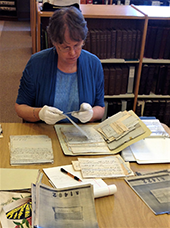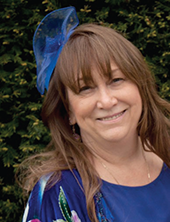Previous Year’s Contest Entries: 2016, 2015, 2014
Read the 2017 “I Found it in the Archives” state finalist essays below and vote for your favorite in the side navigation of any page on the SOA website.
Voting begins August 14, 2017 and ends August 31, 2017.
If viewing the contest on a mobile device, please scroll down to the bottom of the page to place your vote.
Entry #1
Heartwarming “Aha” Moments
Perched on his grandfather’s knee, my father absorbed first-hand tales of the Civil War. William T. Mereness, Union Veteran, was no doubt his hero. Many decades later, I began my genealogical search with WTM’s National Archives military records. Among the large file of depositions and medical reports, I found enough to set my sights on Clark County, where he had enlisted in 1861.
Since then, I’ve amassed a great deal of research. And for eight years, I volunteered at Atlanta’s National Archives regional branch, patiently winding through countless reels of microfilm. But I know nothing surpasses the thrill of handling original records. And so, after 35 years on the imaginary trail of my ancestors, I finally drove from North Carolina to dig in.
The Heritage Center’s helpful staff guided me to many useful – and fruitful! – resources. Yet nothing made my heart beat faster than the sight of tantalizingly thick Probate files. Having discovered that WTM’s father might be Abraham M Mereness, and that AMM’s father might be Abraham D Mereness, I searched for proof. Sadly, ADM perished in the cholera epidemic that raged in the summer of 1849 – he had not made a will. However, in his estate settlement, AMM’s name appeared often. Was he an heir?
We had assumed that our family descended from the multitude of Mereness families who settled Dutch NY, but lacked proof. As fate would have it, there was a letter in ADM’s file postmarked soon after his death, bringing news “from the land of your boyhood”. At last, our history connected.
Lengthy inventory pages of his “earthly goods and chattels”, and heaps of handwritten notes regarding accounts to settle, helped bring this ancestor alive! Dresses made for his wife; carpet for his “drawing room”; copper kettles, brass candlesticks; even a “buffalo robe” and a “squirrel house”. A listing for “stair carpet and rods” tells me his home was two-story. His moderate wealth and social standing are revealed by such items as “silver sugar tongs” and “white silk gloves”. Suddenly his life seems real.
What could be more poignant than a receipt for “1 bottle Davis’s Pain Killer” on August 7, 1849 and a receipt for carriages “attending the funeral” on August 8? But my heart leaped when at last I held a small scrap of paper in ADM’s file, handwritten and signed by AMM. acknowledging receipt of “my father’s gold watch”!

Anne Strupp
Clark County Historical Society
Entry #2
Ohio Archives – Swan/Whiting Family Photos
I found treasure in the Ohio archives when doing research for a story I was writing.
I’d stumbled upon a tale of scandal from 1883 involving a débutante, Sara Swan Whiting. A
popular beauty born in Newport, Rhode Island, Sara’s family was a welcome member of the
famous New York “Four Hundred” social elite set, ruled by society’s matriarch, Mrs. Caroline
Astor. Sara was a favorite of Mrs. Astor, and close friends with her daughter, Carrie Astor and
Edith (Jones) Wharton.
I learned that Sara Swan Whiting became involved in a scandal after falling in love
with Oliver Belmont, son of financier August Belmont. Sara and Oliver were married, but
the marriage only lasted several months when Oliver abandoned his bride on their Paris
honeymoon, delivering Sara to horrible scandal.
While hunting for information I was unable to find any photos of Miss Whiting, or
her family, who played an intricate role in her failed marriage. Her mother, Mrs. Sara Swan
Whiting, and two older sisters, Jane and Millie Whiting, as well as a brother, Augustus Whiting.
I finally found several photos of Sara at the New York Historical Society, but no portraits or
other photos. This is unusual for a woman of her social standing. There are many portraits and
photos of her friends, Carrie Astor and Edith Wharton, but few of Sara and none of the Whiting
family.
I assumed this was fallout from the scandal. It was almost as though Sara had been
wiped from the records of history.
Research into Sara’s genealogy revealed she was the granddaughter of Judge Gustavus
Swan. Judge Swan had a successful legal career in Ohio, and summered in Newport, R.I..
Admitted to the bar in 1811, he went on to serve in the Ohio House of Representatives, the Ohio Supreme Court, president judge of the Ohio Court of Common Pleas, and president on the board of the Bank of Ohio. Judge Swan died in Columbus in 1830, leaving his name in Ohio’s history books.
Imagine my delight when an Ohio historian located photos of the Whiting family mixed
in with their cousins, the Parson family! Although none were found of Sara, probably because
she was a baby, the historian found photos of Sara’s mother, her sisters, Jane and Millie, and
her brother Augustus. These photos were a visual gold mine, putting faces to names of a well
respected Ohio family!

Janet Peterson
The Ohio History Connection
Last Updated on October 16, 2020 by janet_carleton
